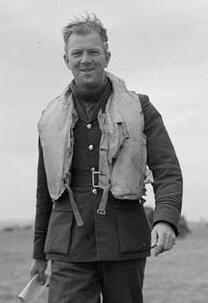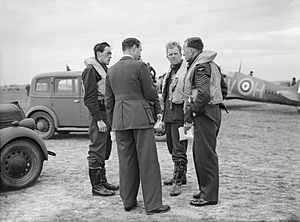Walter Lawson (RAF officer) facts for kids
Quick facts for kids
Walter Lawson
|
|
|---|---|

Lawson, September 1940
|
|
| Nickname(s) | 'Farmer' |
| Born | January 1913 Taunton, United Kingdom |
| Died | 28 August 1941 (aged 28) off the Dutch Coast |
| Allegiance | United Kingdom |
| Service/ |
Royal Air Force |
| Years of service | 1934–1941 † |
| Rank | Squadron Leader |
| Commands held | No. 19 Squadron |
| Battles/wars | Second World War |
| Awards | Distinguished Flying Cross |
Walter Lawson (January 1913 – 28 August 1941) was a brave flying ace who flew for the Royal Air Force (RAF) during the Second World War. A "flying ace" is a pilot who has shot down five or more enemy aircraft. Walter Lawson was officially credited with shooting down at least six enemy planes.
Born in Taunton, England, Walter joined the RAF in 1929. He first trained as a fitter, which is someone who builds or repairs aircraft. Later, he became a pilot. He didn't see much action at the start of the Second World War. But in April 1940, he joined No. 19 Squadron. He flew many missions during the Battle of Britain, where he achieved several victories in the sky. In July 1941, he became the leader of his squadron. Sadly, he was killed in action the next month, at just 28 years old.
Contents
Early Life and Training
Walter John Lawson, also known as Jack, was born in January 1913. His hometown was Taunton, in Somerset, England. His father was an officer in the British Army. Walter went to school at Hastings Grammar.
In January 1929, Walter joined the Royal Air Force (RAF) as an apprentice. He trained to be an aircraft fitter. He finished this training in late 1931. After that, he decided he wanted to fly planes himself! In March 1936, he started his flight training. He learned to fly at No. 10 Elementary Flying Training School. Then he went to No. 10 Flying Training School. There, he earned his pilot's wings, which meant he was ready to fly.
World War II Service
When the Second World War began, Walter Lawson was a sergeant with No. 46 Squadron. His squadron was based at Digby. They flew Hawker Hurricane fighters. Their job was to patrol the east coast of England. These early patrols were mostly quiet.
In April 1940, Walter became a pilot officer. This meant he was now an officer in the RAF. Later that month, he moved to No. 19 Squadron. Here, he quickly got the nickname 'Farmer'. This was because he planned to become a farmer after the war ended.
No. 19 Squadron was based at Duxford. They flew the amazing Supermarine Spitfire fighter plane. This squadron was the very first in the RAF to get the Spitfire in 1938. When Walter joined, the squadron mostly flew patrols to protect ships. But in late May, they helped protect the beaches at Dunkirk during Operation Dynamo. This was a huge rescue mission for Allied soldiers.
Battle of Britain Flights
At first, the Spitfires of No. 19 Squadron had cannons. But these cannons often didn't work well. This made it hard for them to fight in the early part of the Battle of Britain. By September, they switched back to standard machine guns. Then, they flew regularly as part of the Duxford Wing.
On September 5, Walter was promoted to flight lieutenant. He also became a flight commander, leading a group of planes. On this day, he fought a Dornier Do 17 bomber. He claimed it was probably destroyed over Maidstone. He also damaged a Messerschmitt Bf 109 fighter. Four days later, near Biggin Hill, he shot down a Messerschmitt Bf 110 heavy fighter.
On September 11, he destroyed a Heinkel He 111 bomber over Gravesend. On September 15, he probably destroyed another Do 17 over London. Three days later, he helped destroy a Junkers Ju 88 bomber east of London. On September 27, he shot down a Bf 109 over the Thames Estuary.
As October arrived, there were fewer battles with the Luftwaffe (German air force). But Walter still had success. On November 5, he destroyed two Bf 109s in separate flights. One was near Dungeness and the other over the Thames Estuary.
For his bravery, Walter was given the Distinguished Flying Cross. This is a very important award. The official announcement was made on November 26. The award said he "consistently led his flight... with great skill and courage." It also said he "destroyed at least five enemy aircraft." It praised his "exceptional coolness" and how he inspired other pilots.
During the winter months, fighting slowed down. Walter was officially promoted to flying officer. He continued to act as a flight lieutenant.
Later Missions and Loss
The RAF changed its tactics. Instead of just defending, they started flying missions into France and the Low Countries. These were called "fighter sweeps" or "escorts" for bombers. This was part of the circus offensive.
On June 27, 1941, Walter's squadron flew a mission to Lille, France. They were protecting 24 Bristol Blenheim light bombers. Over the French coast, they saw several Bf 109s. Walter's squadron attacked them. Walter destroyed one Bf 109 and probably destroyed another.
In July, Walter was promoted to squadron leader. He was given command of No. 19 Squadron. On August 28, his squadron was part of a fighter sweep to Rotterdam. They were surprised by Messerschmitt Bf 109 fighters from Jagdgeschwader 53. During the fight, Walter Lawson's plane was shot down off the Dutch coast.
His squadron searched for him the next day, but they found no trace. It was believed that he had been killed. Walter Lawson has no known grave. He is remembered at the Air Forces Memorial near Egham in Surrey, England. At the time of his death, he was credited with shooting down seven German aircraft. He also probably destroyed three and damaged one.


